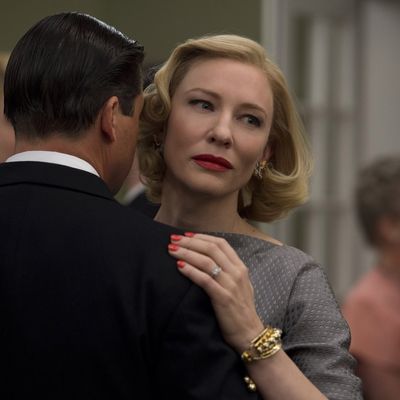
In the first scene of Todd Haynes’s romantic lesbian drama Carol, there’s a moment that seemed so floridly sentimental I couldn’t keep myself from laughing out loud. The scene actually comes late in the story (most of the film is a flashback) and shows the two main characters in a fancy restaurant. The older, wealthy Carol Aird (Cate Blanchett) stares urgently into the eyes of Therese Belivet (Rooney Mara), who gazes back sorrowfully. Interrupted by a male acquaintance of Therese, Carol rises to leave and, as she does, lets her hand linger a moment on Therese’s arm. What made me laugh was how Rooney looked down at the hand on her arm in a way that seemed slower than a Kabuki actor, her eyes widening as if her soul were struggling to explode from her head. The longing … the longing … Probably the highest compliment I can pay Carol is that an hour and a half later, when we return to that scene and the moment is repeated, I didn’t laugh. The entire movie has unfolded in a trance, so that Carol’s touch and Therese’s reaction seem genuinely momentous.
Carol is based on a novel called The Price of Salt by Patricia Highsmith, who — being well closeted — first published it under a pseudonym. The book isn’t as flowing or earnest as the film, but it’s surprisingly upbeat, written while she was working in the toy section of a department store, where she caught sight of a fur-coated middle-aged woman who fired her imagination — well before the homophobic world helped to turn Highsmith into a cynical old meanie. Haynes and the playwright Phyllis Nagy have conceived Carol in the same ultradeliberate, sumptuous Technicolor style of Haynes’s Far From Heaven, which was a sort of living museum exhibit to the romantic melodramas of Douglas Sirk. If anything, the emotions of Carol are more compressed, distilled into small gestures, furtive looks, the play of light over fabrics, the cooling and heating frequencies of color.
Haynes has calibrated the film so precisely to Blanchett’s talents that he couldn’t have rendered her better with animation. The key to her performance is its play of heavy and quick, regal and furtive. The heaviness is in her features — in her full lips; spectacularly high, rounded cheekbones; and her languid, feline eyes, all of which make her look as expensive as her furs, cars, and New Jersey mansion. Against this: the tiny, involuntary glances toward Therese — a snap of longing and snap back to composure, sometimes so fast you’d need to slow it down to see it fully, like the move of a Venus fly trap. It’s very artificial, but Blanchett is an artificial actress, brilliantly calibrating her effects. Both she and Haynes make me think of soulful animatronics.
Mara goes the opposite way, transforming herself into a gamine and making herself so receptive to Blanchett that the aforesaid snaps hit her like blows. She’s so mesmerized that she could be doing a mirror-exercise; her eyes move in sync with Blanchett’s gestures. Her Therese is a dazed bystander to the battles between Carol and her seething, abandoned husband (Kyle Chandler), who’s ready to bring out the big guns to keep Carol from their child; and she can only stare, open-mouthed in confusion, at Carol’s sympathetic ex-lover (Sarah Paulson, likably down-to-earth amid the histrionics). This might be the Love That Dares Not Speak Its Name, but it plays a mean charades.
I know many people who marvel at Haynes’s deconstructionist tendencies and many others who think that he deconstructs his stories because he doesn’t know how to construct them. Ogling those overripe colors while listening to Carter Burwell’s ersatz–Philip Glass stylings, I found myself agreeing completely with the naysayers while still giving a slight edge to Haynes’s adherents. He is a sensuous pointy-head. Groping through the accumulated bric-a-brac of cinema’s signs and signifiers toward the light, he proves in Carol that deconstruction can be gloriously romantic.
*This article appears in the November 16, 2015 issue of New York Magazine.


